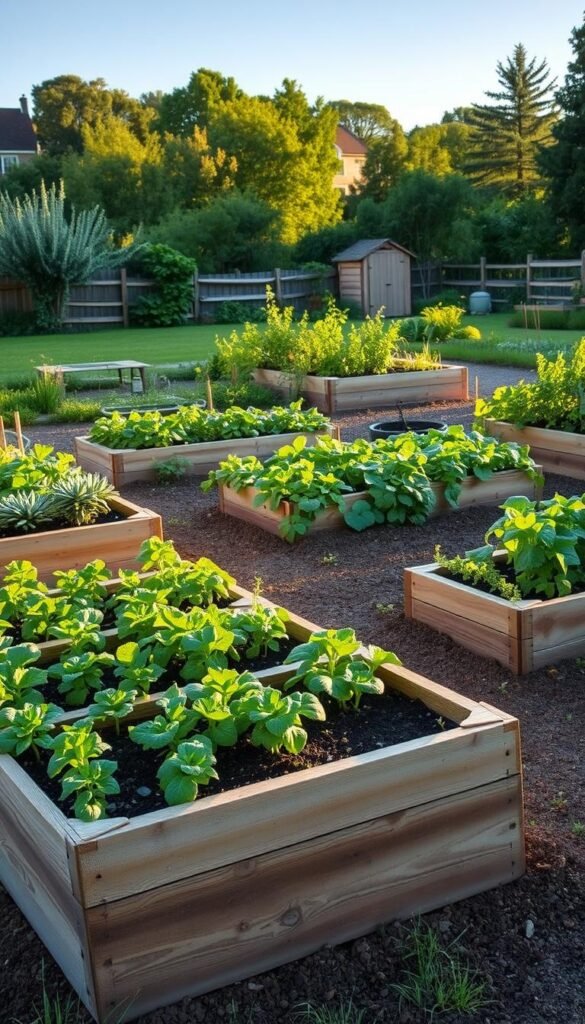Starting a home vegetable patch? You’ve likely heard about two main growing styles. One uses containers or boxes filled with soil, while the other relies on planting directly into the earth. Both methods have unique perks, but your choice depends on space, budget, and how much control you want over your plants’ environment.
Controlled soil quality and drainage make container setups popular for urban spaces or tricky landscapes. These structures let you customize your mix of nutrients and prevent compaction. They’re especially handy if your natural ground has poor drainage or contaminants.
On the flip side, traditional planting areas work with what’s already there. Adding compost or organic matter can boost native soil without building frames. This approach often costs less upfront and suits larger plots where roots can spread freely.
Your goals matter too. Do you prioritize easy access for tending plants? Maybe you’re balancing aesthetics with practicality. We’ll break down how each option handles weeds, pests, and seasonal changes so you can pick what aligns with your vision.
By the end of this guide, you’ll know exactly how to match your gardening style to the method that’ll make your edible oasis thrive. Let’s dig into the details!
Exploring Your Edible Garden Design Options
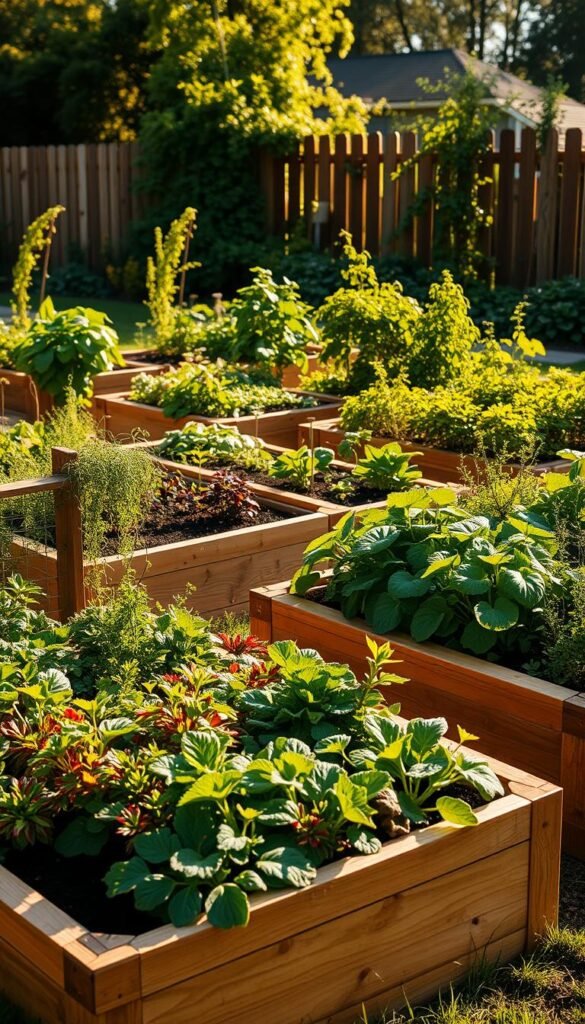
Your dream harvest begins with smart spatial planning. Whether you’re working with a sprawling backyard or a compact patio, blending raised beds and in-ground gardens unlocks creative solutions. Many growers mix both styles—using elevated planters for tomatoes and peppers while tucking rosemary or blueberries directly into the earth.
Sunlight patterns and garden space shape your layout. Elevated planters shine in areas with partial shade—they let you position veggies where light lasts longest. Got a sloped yard? Terraced beds prevent erosion while maximizing usable ground. For step-by-step guidance on constructing these structures, check out our raised bed tutorial.
Consider these factors when designing:
- Time investment: Raised setups require less bending but more upfront work
- Soil control: Customize planting mix in beds vs. amending native earth
- Seasonal flexibility: Rotate crops easily in modular beds
Your local climate plays a role too. Sandy soils drain faster in ground-level plots, while clay-heavy areas benefit from raised drainage. Start small—try one bed paired with an in-ground herb corner. As confidence grows, expand your design while keeping harvests within easy reach.
Understanding the Benefits of Raised Beds
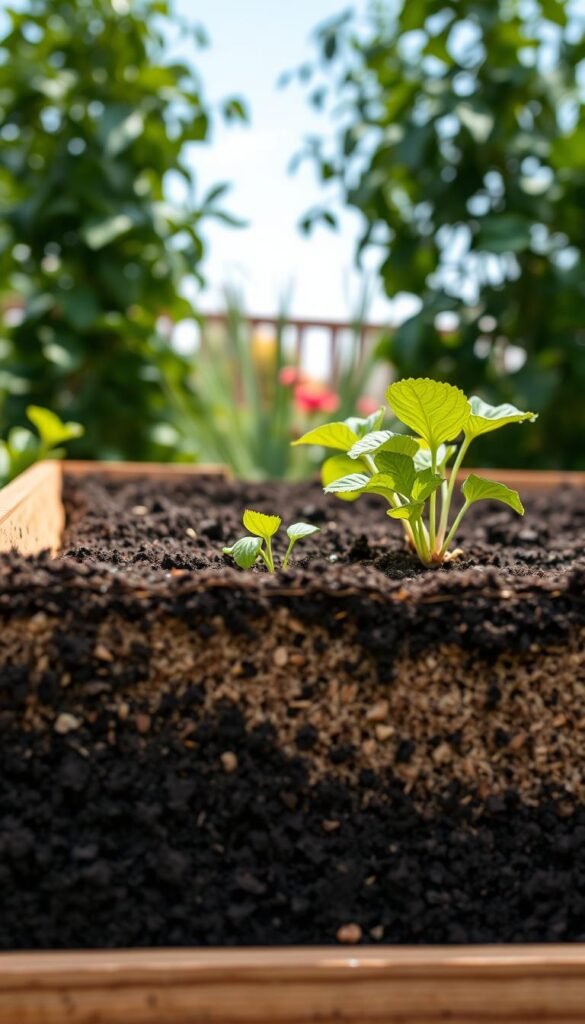
Maximizing plant health starts with the foundation you provide. These elevated growing spaces give you precision control where it matters most—from root conditions to creature comforts for your body.
Enhanced Soil Quality and Drainage
Imagine starting fresh with custom soil blends instead of fighting clay or sand. You mix exactly what your crops crave—compost, perlite, and worm castings in perfect ratios. This tailored approach prevents compaction, letting roots breathe while nutrients flow freely.
Water behaves better here too. Excess moisture drains faster than in flat plots, reducing rot risks. Early spring gardeners love how the soil warms quicker, giving seedlings a two-week head start in many regions.
Effective Pest Prevention and Accessibility
Hungry critters meet their match. The vertical sides deter slugs and rabbits—add a hardware cloth base to block underground invaders. No more waking up to vanished carrot tops!
- Knee-friendly height reduces bending strain
- Simpler weed management in contained spaces
- Adjustable width for easy reaching
Your gardening years extend when tending plants feels effortless. Pair these advantages with smart companion planting, and you’ve built a fortress for your food.
Discovering the Advantages of In-Ground Gardens
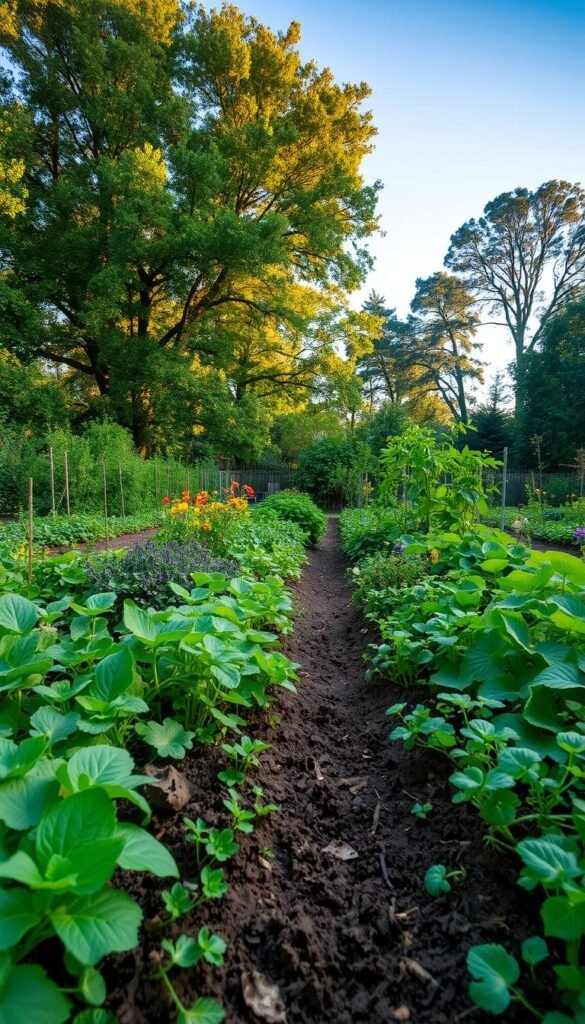
Rooted in simplicity, traditional planting methods let nature do the heavy lifting. When you work with existing earth, you tap into self-sustaining ecosystems that have developed over centuries. This approach shines for growers who want minimal intervention and maximum natural resilience.
Deep-rooted crops like carrots and tomatoes thrive here. Their roots plunge freely into the earth, accessing nutrients and moisture that container-bound plants can’t reach. “Plants know how to feed themselves when we give them space,” notes veteran grower Maria Sanchez. Established plots often skip synthetic fertilizers entirely.
Water management becomes effortless with native soil. Unlike elevated setups that dry out quickly, earth-level planting areas retain moisture like a sponge. During summer droughts, roots dive deeper to find hidden water reserves.
| Feature | In-Ground | Raised Beds |
|---|---|---|
| Watering Frequency | Every 5-7 days | Every 2-3 days |
| Soil Preparation | Amend existing | Buy/pour mix |
| Root Depth Potential | Unlimited | 12-24 inches |
Expanding your plot costs nothing but sweat equity. Simply till new ground and add compost—no lumber or screws required. This flexibility lets you experiment with crop rotations or sprawling plants like pumpkins without rebuilding structures.
While both methods have merits, earth-based growing offers unmatched scalability for those with space. Pair it with smart composting practices, and you’ll build richer soil year after year.
Comparing Soil Quality and Water Management
Healthy plants begin with what’s beneath your feet. Whether you’re growing juicy tomatoes or crisp lettuce, how you manage earth composition and hydration makes all the difference. Elevated planters let you craft ideal growing conditions from scratch, while traditional plots work with existing terrain—each needing distinct strategies for success.
Soil Composition and Amendment Needs
Sandy loam reigns supreme for vegetable growth, blending drainage with moisture retention. With elevated setups, you start fresh—mixing compost, peat moss, and perlite to create a fluffy, nutrient-rich haven. No more battling clay chunks or surprise rocks!
Ground-level plots demand more patience. You’ll test pH levels and gradually improve native earth through amendments. A no-dig approach works wonders here, layering organic matter to boost structure without tilling.
Moisture Retention and Drainage Capabilities
Containers dry out faster than earth plots—sometimes needing daily summer watering. Their loose soil lets excess rain escape quickly, protecting roots from rot. Meanwhile, in-ground systems act like sponges, storing moisture deeper than shovel blades reach.
| Aspect | Elevated Planters | Ground Plots |
|---|---|---|
| Watering Frequency | High (2-3 days) | Low (5-7 days) |
| Root Zone Depth | Limited by frame height | Unrestricted |
| Drainage Speed | Fast | Moderate |
Pest Control and Maintenance Considerations
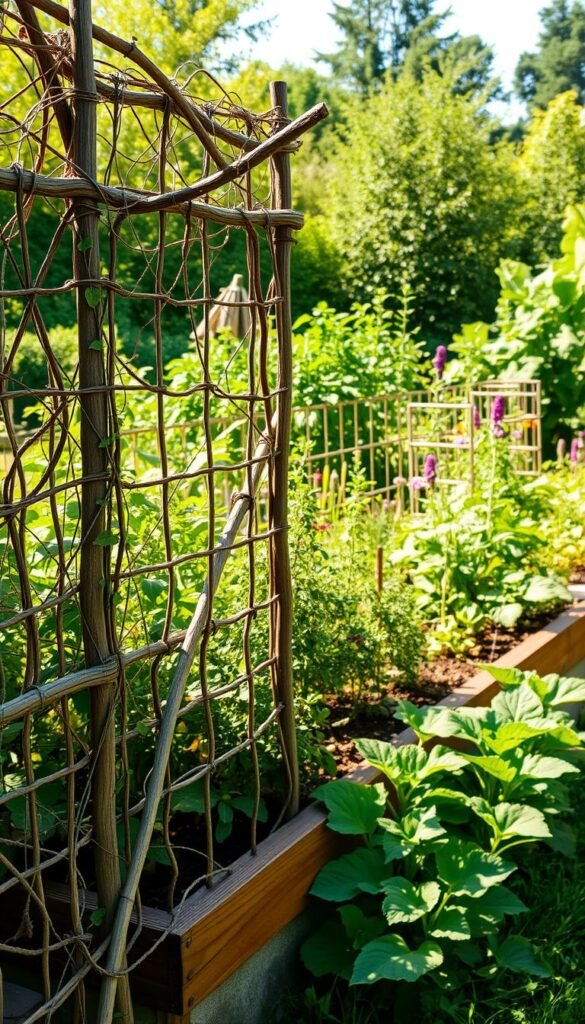
Protecting your crops from unwanted visitors starts with smart design choices. Elevated growing spaces offer built-in defenses that simplify plant care while keeping critters at bay. Let’s explore how strategic setups can reduce headaches and boost yields.
Built-In Defense Systems
The vertical walls of elevated planters act like mini fortresses. Slugs and snails struggle to climb the smooth surfaces, while rabbits often bypass these obstacles entirely. For burrowing animals, a simple hardware cloth layer at the base blocks underground attacks.
Installing protective covers becomes effortless with defined borders. Floating row guards snap into place quickly, shielding plants from flying insects or hungry birds. You’ll spend less time battling invaders and more time enjoying your harvest.
| Protection Method | Elevated Planters | Ground-Level Plots |
|---|---|---|
| Slug Prevention | High (walls + copper tape) | Low (requires bait traps) |
| Burrowing Animal Defense | Hardware cloth installation | Trench digging + wire mesh |
| Weed Suppression | 90% reduction | 40-60% reduction |
Maintenance shifts from chore to choice with contained spaces. Fresh soil mixtures resist weed seeds, while clear boundaries prevent accidental trampling. Your plants stay safer, and your weekends stay freer.
Assessing Cost, Build Effort, and Material Requirements
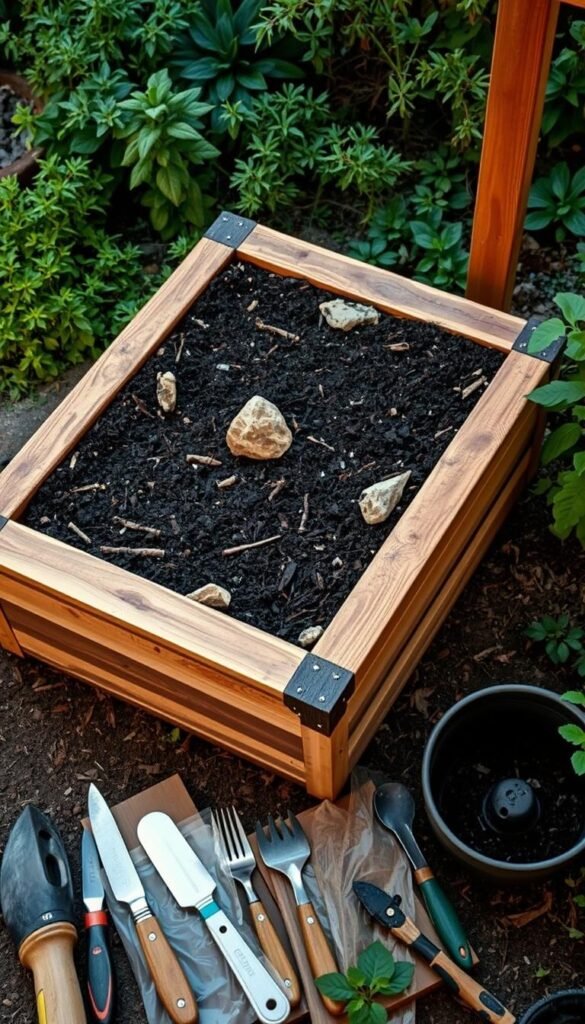
Creating a thriving vegetable patch demands careful planning of both finances and physical resources. The path you choose—constructed planters or natural plots—shapes your wallet and workload for seasons to come.
Initial Investment vs. Long-Term Maintenance
Constructing elevated planters involves upfront expenses that surprise many beginners. Quality cedar or redwood boards cost 3-5 times more than pine but resist rot for 10+ years. You’ll also need galvanized screws, corner brackets, and enough soil to fill every frame—a hidden expense that adds up quickly.
Compare this to traditional plots where your main costs involve compost and a shovel. A well-planned layout maximizes harvests without expensive structures. One gardener shared: “My first season’s budget covered six bags of compost and seeds—everything else came from the earth.”
| Expense | Elevated Planters | Ground Plots |
|---|---|---|
| First-Year Cost | $200-$500 | $20-$100 |
| Decade Cost | $300-$700 | $150-$300 |
| Labor Hours | 8-12 hours | 1-3 hours |
Time investment varies dramatically. Assembling basic rectangles takes an afternoon with power tools, while curved designs demand advanced skills. Remember—every replaced board means emptying heavy soil. Spreading projects across multiple years eases financial strain while letting you refine designs.
Maximizing Garden Space and Design Flexibility
Your edible paradise doesn’t require acres—just clever arrangements that match your environment. Whether you’re working with a postage-stamp balcony or rolling backyard acres, smart layouts turn limitations into lush harvest zones.
Elevated planters revolutionize how you use awkward spots. Set them on paved surfaces, slope them into hillsides, or stack them vertically. One gardener transformed a fire escape into a salad haven using tiered containers. “You’d be surprised what thrives in 18 inches of soil,” says Tom Jacobs, urban gardener.
| Feature | Elevated Planters | Ground Plots |
|---|---|---|
| Location Options | Patios, rooftops, slopes | Natural soil areas only |
| Space Efficiency | 1 lb produce/sq ft* | 0.6 lb produce/sq ft* |
| Design Shapes | Hexagons, L-shapes, tiers | Fixed rows or mounds |
Square foot gardening shines in contained spaces—plant carrots, radishes, and greens in tight grids. This method quadruples yields compared to traditional row planting. Rotate crops seasonally without disturbing neighboring plants.
Larger properties benefit from blending both approaches. Use native soil for sprawling melons or corn, while keeping herbs and lettuces in mobile planters. This hybrid strategy lets you adapt as your needs evolve.
Raised Beds vs. In-Ground: Which Works Best for an Edible Garden Design?
Your perfect growing setup isn’t about picking sides—it’s about matching methods to your landscape and lifestyle. Soil conditions often decide the game before you lift a shovel. If your yard has dense clay or rocky layers, garden beds with custom soil let you bypass the frustration. But if your ground feels rich and crumbly, planting directly saves money and effort.
Think about your movement too. Those with sore knees or limited mobility often find elevated setups more comfortable. One gardener shared: “I went from 10 minutes of weeding to an hour of joyful tending after switching to waist-high planters.” Budget matters as well—building structures costs more upfront than amending existing earth.
- Test soil drainage by digging a 12-inch hole and filling it with water
- Calculate costs for materials vs. soil amendments
- Map sun patterns to position heat-loving plants effectively
Many enthusiasts blend both approaches. Use contained spaces for quick-growing veggies like lettuce and radishes, while reserving ground plots for deep-rooted tomatoes or fruit bushes. A smart square foot gardening layout maximizes yields in smaller raised areas.
Your local climate adds another layer. Sandy regions benefit from in-ground moisture retention, while rainy areas need the drainage boost of elevated setups. Start with one project—maybe herbs in a planter box—then expand as you learn what thrives in your care.
Remember: Great gardening adapts. What works for peppers this year might change when you add raspberries next season. Keep experimenting, and your edible space will grow alongside your skills.
Integrating Practical Garden Tips for Optimal Growth
Crafting a thriving vegetable plot requires smart design choices tailored to your space. Let’s explore how to balance functionality with plant needs, whether you’re working with compact areas or sprawling yards.
Choosing the Right Design for Your Space
Depth matters when building growing containers. Aim for 18-24 inches to let roots develop fully—especially for tomatoes and peppers. Keep widths under 4 feet so you can reach plants without stepping on soil.
Match crops to their environment. Sprawling melons and pumpkins thrive in open ground plots, while heat-loving varieties like eggplants perform better in elevated setups. Cool-weather greens prefer the steady moisture of earth-level garden beds.
Consider these factors:
- Microclimate effects: Containers warm faster in spring
- Access needs: Narrow paths between structures prevent compaction
- Soil health: Blend compost into native earth or use custom mixes
Your layout should reflect local conditions. Sandy regions benefit from in-ground moisture retention, while clay-heavy areas need drainage-focused designs. For nutrient-rich soil strategies, explore our guide to organic gardening practices.
Remember: Successful growing spaces evolve. Start small, observe what works, and expand gradually. Your plants will tell you when they’re happy!
Wrapping Up Your Garden Design Journey
Your gardening adventure doesn’t end with a single choice—it’s an evolving relationship with the earth. Both raised beds and in-ground gardens offer unique rewards, and mixing methods often yields the tastiest results. Start small with one approach, then let your experience guide future expansions.
Many growers discover that combining techniques works best. Use elevated planters for quick-growing veggies like spinach and radishes, while letting tomatoes stretch their roots in native soil. This hybrid strategy maximizes yields and minimizes frustration.
Your space will transform over years as you learn what thrives in your care. Rocky soil might inspire more built beds, while fertile ground could expand your earth-grown crops. Remember: great gardening adapts to your changing needs and discoveries.
Whether you’re nurturing herbs in containers or planting berry bushes directly in the ground, focus on what brings you joy. The perfect layout balances practicality with personal satisfaction—your harvest should taste like victory, not stress. Now grab those gloves and grow something delicious!

